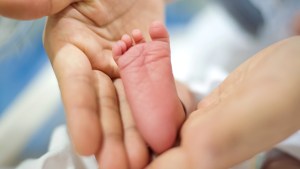A couple of months after my conversion to the Catholic faith, in July 2013, I stopped taking the contraceptive pill. The pill had been a normal part of my life for about five years. My menstrual cycle failed to pick up again, however, and in 2015, when my then boyfriend and I were making plans to get engaged, I approached a natural family planning (Sensiplan) counselor. She instructed me to start recording relevant fertility data based on self-examination (chiefly, basic temperature at time of awakening and cervical mucus).
When I spoke to a doctor who specialized in Sensiplan in the fall of 2015, her assessment was hard to stomach. My cycle charts were not interpretable, she said. There were way too many irregularities. She was right — my sleep pattern was unpredictable. On many days I didn’t get seven hours of sleep (this was even worse as a student). I worked in an international law firm back then, an environment not exactly known for its balanced work hours. I was a perfectionist by nature and had many commitments. The doctor concluded: “Perhaps your body is telling you it is not ready to carry a baby right now.”
Presumably, I had PCOS (polycystic ovarian syndrome). This means that many eggs are rimming the ovaries, trying to mature, but because of disturbances in the hormonal system, no ovulation occurs. This is reflected in irregular cycles. Between 2 and 20 percent of women ages 18 to 44 get this diagnosis.
In September 2016, one month before our marriage, my fiancé and I went to see Dr. Susanne van der Velden in Kleve, Germany, one of the few gynecologists in our region working with NaPro Technology. NaPro Technology (Natural Procreation Technology) addresses the underlying causes of sub-fertility and infertility while respecting the dignity of each human life, as well as the sacred nature of the marital act. My diagnosis was very different, but complementary: I was too thin! Gaining some extra weight would positively impact my estrogen and progesterone levels: “every additional kilo is a plus” I was told. Since my wedding dress was already tailored, I would wait until after the wedding ceremony to make work of it.
It struck me how Dr. van der Velden insisted on the shared responsibility of our fertility: It was both my husband and me who would need to ensure a stable, calm, and regular environment in the home.
In the third cycle following our wedding, I got pregnant.
The first weeks were difficult. My hormone levels were unlikely to support this new life, potentially leading to a miscarriage. Dr. van der Velden continued to counsel me with NaPro Technology throughout the pregnancy as my “hormone captain,” monitoring the evolution of the pregnancy hormones through regular blood tests. Whenever necessary, I took additional progesterone or estrogen. The therapy worked.
After a couple of months, I had another wake-up call. Without realizing it, the stress of my job was negatively impacting my hormone balance again. Dr. van der Velden insisted I take a step back professionally. I did something I never would have done if it were up to me: ask my supervisor to cut my hours back. Luckily, he accepted my request and the rest of my pregnancy I worked from 9:30 to 4:30.
On October 22, 2017, we were delighted to welcome our perfectly healthy wonder-baby, Mathilde.
I am deeply convinced that the way we, ambitious and career-minded women, live our overscheduled lives today is not conducive to fertility. We expose ourselves to a lot of stress. Waiting for all conditions to be “perfect” — obtaining a graduate degree, getting the necessary promotions, having first a couple of years of “we” time after the wedding and settling in your dream house — may not turn out to be the best strategy to start a family. Deep down, we all know what is best for our bodies and for our chances to get pregnant naturally: harmony, inner peace, joy, a stable relationship full of love, inner freedom… Unsurprisingly, this is also what God asks of us, and what He helps us to achieve through the works of the Holy Spirit.
NaPro Technology led me to live a more moderate life, with lower stress levels, more sleep, and temperance in the demands I make on myself. It helped me take the limits of our human freedom to heart, and somehow liberated me.
Another law of the spiritual life is applicable in NaPro Technology: the law of patience, of waiting, of surrendering to the timing and ways of the Lord, of having this “wide” trustful soul, of seeing new life (and all life in general) as a gift that one does not possess. There is a deep link between sexuality and the spiritual life.
In contemporary society children are not seen as a gift, but as something we expect to have, or that have a right to. In other words, children are perceived as an object of the will. This fits perfectly with Western thinking, where the unborn do not have an inherent objective dignity, but where their value is derived from the degree of “wanted-ness” by their parents (subjectivism, in other words).
NaPro Technology founder Dr. Thomas Hilgers, of the Pope Paul VI Institute, says in
that the Catholic Church has so much to offer in the field of fertility. It presents a wholly different paradigm than the one we are used to in our post-sexual revolution times. This beautiful approach is holistic (making you a better person, as well as improving your relationship with God, and fostering spousal love), deeply human, and embedded in a tremendously beautiful theology of over 2,000 years old.
Read more:
NaPro Technology Instead of IVF? It’s Not So Simple

